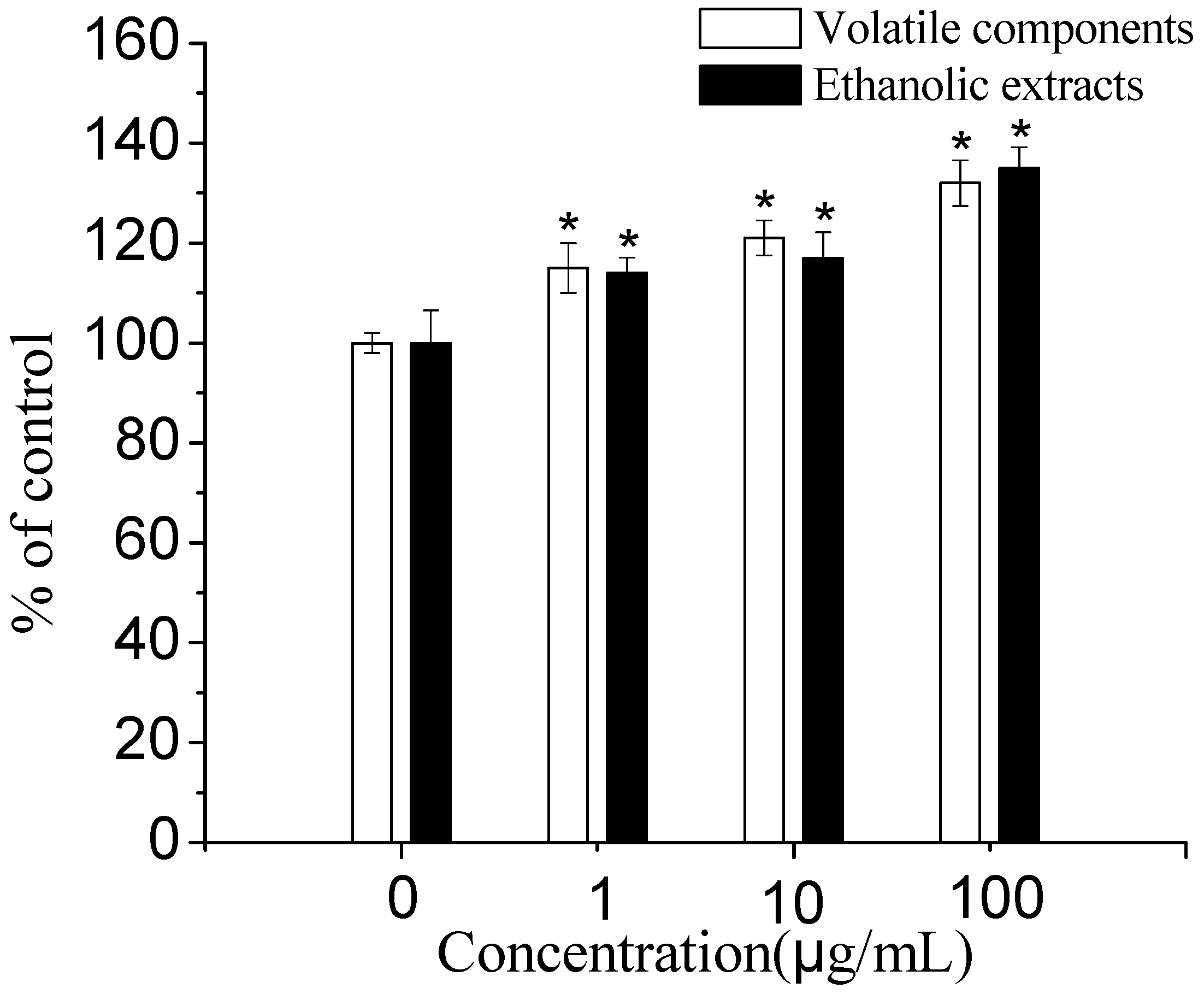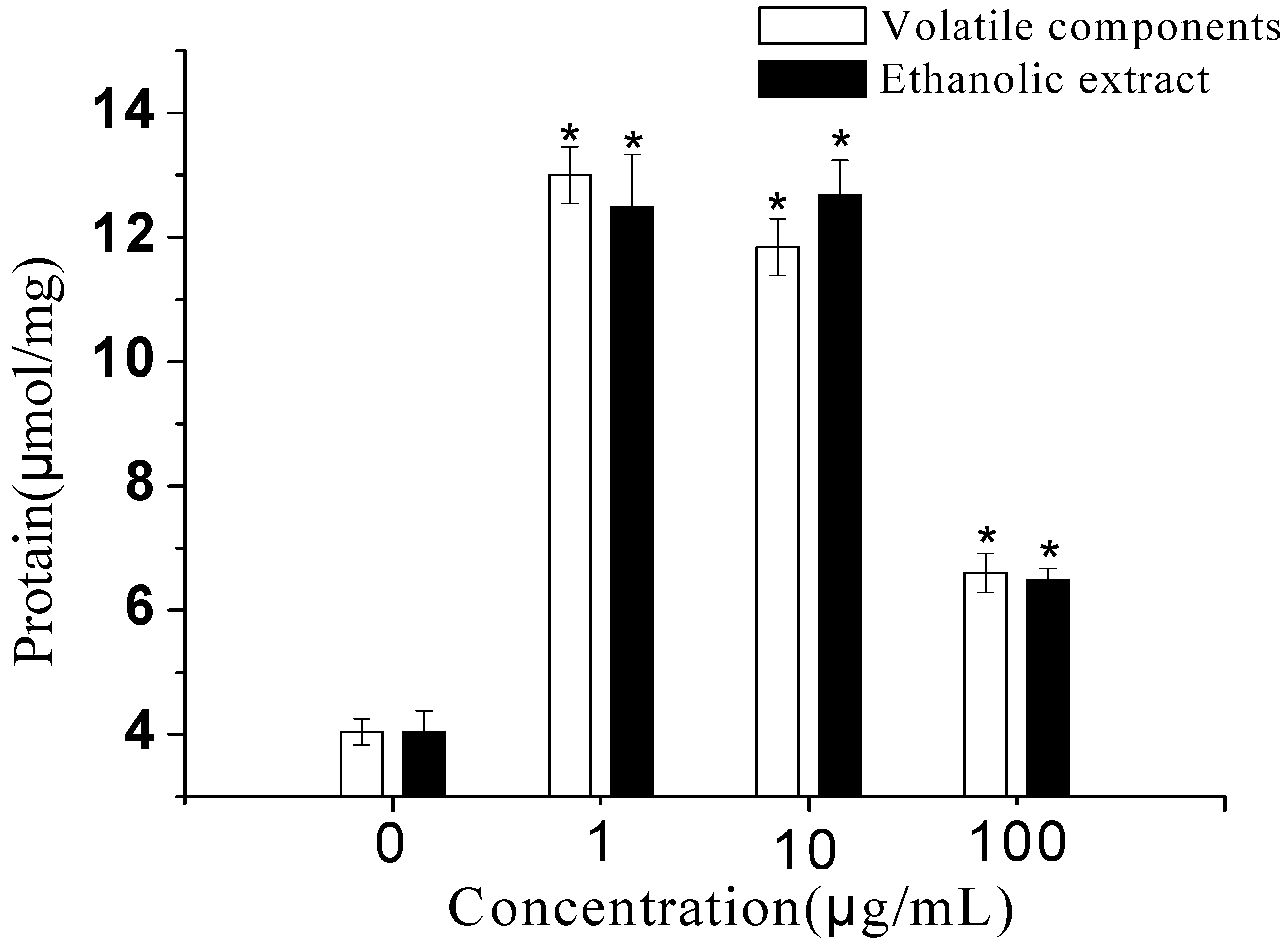Effects of Volatile Components and Ethanolic Extract from Eclipta prostrata on Proliferation and Differentiation of Primary Osteoblasts
Abstract
:Introduction
Results and Discussion
Volatile components analysis


Proliferation and alkaline phosphatase activity assays
Experimental
Plant material
Chemicals and reagents
Extraction of volatile components
GC–MS analysis
Identification and quantification of volatile components
Ethanolic extract
Preparation of test samples
Cell cultures
Assay for osteoblast proliferation and alkaline phosphatase (ALP) activity
Statistical analysis
Conclusions
Acknowledgements
References
- Rodan, G.A.; Martin, T.J. Therapeutic approaches to bone diseases. Science 2000, 289, 1508–1514. [Google Scholar] [CrossRef]
- Kong, Y.Y.; Penninger, J.M. Molecular control of bone remodeling and osteoporosis. Exp. Gerontol. 2000, 35, 947–956. [Google Scholar] [CrossRef]
- Teitelbaum, S.L. Bone resorption by osteoclasts. Science 2000, 289, 1504–1508. [Google Scholar] [CrossRef]
- Persson, I.; Weiderpass, E.; Bergkvist, L.; Bergström, R.; Schairer, C. Risks of breast and endometrial cancer after estrogen and estrogen-progestin replacement. Cancer Cause. Control 1999, 10, 253–260. [Google Scholar] [CrossRef]
- Watts, N.B. Bisphosphonate treatment of osteoporosis. Clin. Geriatr. Med. 2003, 19, 395–414. [Google Scholar] [CrossRef]
- Kalu, D.N. The ovariectomized rat model of postmenopausal bone loss. Bone Miner 1991, 15, 175–192. [Google Scholar] [CrossRef]
- Axelson, M.; Sjövall, J.; Gustafsson, B.E.; Setchell, K.D.R. Soya–a dietary source of the non steroidal oestrogen equal in man and animals. J. Endocrinol. 1984, 102, 49–56. [Google Scholar]
- Fromigue, O.; Modrowski, D.; Marie, P.J. Growth factors and bone formation in osteoporosis: Roles for fibroblast growth factor and transforming growth factor beta. Curr. Pharm. Design 2004, 10, 2593–2603. [Google Scholar] [CrossRef]
- Kaufman, J.M.; Goemaere, S. Osteoporosis in men. Best Pract. Res. Clini. Endoc. Met. 2008, 22, 787–812. [Google Scholar] [CrossRef]
- Cherdshewasart, W.; Bhuntaku, P.; Panriansaen, R.; Dahlan, W.; Malaivijitnond, S. Androgen disruption and toxicity tests of Butea superba Roxb., a traditional herb used for treatment of erectile dysfunction, in male rats. Maturitas 2008, 60, 131–137. [Google Scholar]
- Wu, Y.B.; Zheng, C.J.; Qin, L.P.; Sun, L.N.; Han, T.; Jiao, L.; Zhang, Q.Y.; Wu, J.Z. Antiosteoporotic activity of anthraquinones from Morinda officinalis on osteoblasts and osteoclasts. Molecules 2009, 14, 573–583. [Google Scholar] [CrossRef]
- Zhang, H.; Xing, W.W.; Li, Y.S.; Zhu, Z.; Wu, J.Z.; Zhang, Q.Y.; Zhang, W.; Qin, L.P. Effects of a traditional Chinese herbal preparation on osteoblasts and osteoclasts. Maturitas 2008, 61, 334–339. [Google Scholar]
- Kim, K.W.; Suh, S.J.; Lee, T.K.; Ha, K.T.; Kim, J.K.; Kim, K.H.; Kim, D.I.; Jeon, J. H.; Moond, T.C.; Kim, C.H. Effect of safflower seeds supplementation on stimulation of the proliferation, differentiation and mineralization of osteoblastic MC3T3-E1 cells. J. Ethnopharmacol. 2008, 115, 42–49. [Google Scholar] [CrossRef]
- Lee, U.D.; Suh, S.J.; Kim, K.S.; Kim, D.S.; Jin, U.H.; Lee, I.S.; Yoon, U.H.; Kim, C.H. Immunomodulatory activity of Ulmus davidiana Planch (Ulmaceae) water and ethanolic extracts on bone cells: Stimulation of proliferation, alkaline phosphatase activity and type I collagen synthesis. Environ. Toxicol. Pharmacol. 2007, 23, 154–161. [Google Scholar] [CrossRef]
- Ko, K.M.; Mak, D.H.F.; Chiu, P.Y.; Poon, M.K.T. Pharmacological basis of ‘Yang-invigoration’ in Chinese medicine. Trends Pharm. Sci. 2004, 25, 3–6. [Google Scholar] [CrossRef]
- Luo, Z.G.; Zhao, Y.; Wang, A.T.; Yu, W.S.; Hu, P.; Feng, B. Effect of serum containing Chinese herb of strengthening kidney on proliferation and differentiation of human osteoblast. Bone 2006, 38, S5–S22. [Google Scholar]
- Zhang, J.W.; Li, S.K.; Wu, W.J. The main chemical composition and in vitro antifungal activity of the essential oils of ocimum basilicum Linn. var. pilosum (Willd.) Benth. Molecules 2009, 14, 273–278. [Google Scholar] [CrossRef]
- Manenzhe, N.J.; Potgieter, N.; Ree, T. Composition and antimicrobial activities of volatile components of Lippia javanica. Phytochemistry 2004, 65, 2333–2336. [Google Scholar] [CrossRef]
- Cardile, V.; Russo, A.; Formisano, C.; Rigano, D.; Senatore, F.; Arnold, N.A.; Piozzi, F. Essential oils of Salvia bracteata and Salvia rubifolia from Lebanon: Chemical composition, antimicrobial activity and inhibitory effect on human melanoma cells. J. Ethnopharmacol 2009, 126, 265–272. [Google Scholar] [CrossRef]
- Kim, D.I.; Lee, S.H.; Choi, J.H.; Lillehoj, H.S.; Yu, M.H.; Lee, G.S. The butanol fraction of Eclipta prostrata (Linn)effectively reduces serum lipid levels and improves antioxidant activities in CD rats. Nutr. Res. 2008, 28, 550–554. [Google Scholar] [CrossRef]
- Kumari, C.S.; Govindasamy, S.; Sukumar, E. Lipid lowering activity of Eclipta prostrata in experimental hyperlipidemia. J. Ethnopharmacol. 2006, 105, 332–335. [Google Scholar] [CrossRef]
- Ogunbinu, A.O.; Flamini, G.; Cioni, P.L.; Ogunwande, I.A.; Okeniyi, S.O. Essential oil constituents of Eclipta prostrata (L.)L. and Vernonia amygdalina Delile. Nat. Prod. Commun. 2009, 4, 421–424. [Google Scholar]
- Yu, J.Q.; Yu, H.D.; Zou, G.L. Study on chemical composition of essential oil from Eclipta prostrata. Chin. Pharm. J. 2005, 40, 895–896. [Google Scholar]
- Zhang, J.; Munger, R.G.; West, N.A.; Cutler, D.R.; Wengreen, H.J.; Corcoran, C.D. Antioxidant intake and risk of osteoporotic hip fracture in Utah: an effect modified by smoking status. Am. J. Epidemiol. 2006, 163, 9–17. [Google Scholar]
- Karthikumar, S.; Vigneswari, K.; Jegatheesan, K. Screening of antibacterial and antioxidant activities of leaves of Eclipta prostrata (L). Sci. Res. Essay 2007, 2, 101–104. [Google Scholar]
- Aubin, J.E.; Liu, F.; Malaval, L.; Gupta, A.K. Osteoblast and chondroblast differentiation. Bone 1995, 17, 77–83. [Google Scholar] [CrossRef]
- Evans, D.B.; Bunning, R.A.D.; Russell, R.G.G. The effects of recombinant human interleukin-1β on cellular proliferation and the production of prostaglandin E2, plasminogen activator, osteocalcin and alkaline phosphatase by osteoblast-like cells derived from human bone. Biochem. Biophys. Res. Commun. 1990, 166, 208–216. [Google Scholar] [CrossRef]
- Lee, M.K.; Ha, N.R.; Yang, H.; Sung, S.H.; Kim, Y.C. Stimulatory constituents of Eclipta prostrata on mouse osteoblast differentiation. Phytother. Res. 2009, 23, 129–131. [Google Scholar] [CrossRef]
- Chen, T.L.; Fry, D. Hormonal regulation of the osteoblastic phenotype expression in neonatal murine calvarial cells. Calcif. TissueInt. 1999, 64, 304–309. [Google Scholar] [CrossRef]
- Owen, T.A.; Aronow, M.; Shalhoub, V.; Barone, L.M.; Wilming, L.; Tassinari, M.S.; Kennedy, M.B.; Pockwinse, S.; Lian, J.B.; Stein, G.S. Progressive development of the rat osteoblast phenotype in vitro: Reciprocal relationship in expression of genes associated with osteoblast proliferation and differentiation during formation of the bone extracelluar matrix. J. Cell. Physiol. 1990, 143, 420–430. [Google Scholar] [CrossRef]
- Bradford, M.M. A rapid and sensitive method for the quantitation of microgram quantities of protein utilizing the principle of protein-dye binding. Anal. Biochem. 1976, 72, 248–254. [Google Scholar] [CrossRef]
- Sample Availability: Samples of volatile components and ethanolic extract from the aerial parts of E. prostrata are available from the authors.
© 2010 by the authors; licensee Molecular Diversity Preservation International, Basel, Switzerland. This article is an open-access article distributed under the terms and conditions of the Creative Commons Attribution license (http://creativecommons.org/licenses/by/3.0/).
Share and Cite
Lin, X.-H.; Wu, Y.-B.; Lin, S.; Zeng, J.-W.; Zeng, P.-Y.; Wu, J.-Z. Effects of Volatile Components and Ethanolic Extract from Eclipta prostrata on Proliferation and Differentiation of Primary Osteoblasts. Molecules 2010, 15, 241-250. https://doi.org/10.3390/molecules15010241
Lin X-H, Wu Y-B, Lin S, Zeng J-W, Zeng P-Y, Wu J-Z. Effects of Volatile Components and Ethanolic Extract from Eclipta prostrata on Proliferation and Differentiation of Primary Osteoblasts. Molecules. 2010; 15(1):241-250. https://doi.org/10.3390/molecules15010241
Chicago/Turabian StyleLin, Xiong-Hao, Yan-Bin Wu, Shan Lin, Jian-Wei Zeng, Pei-Yuan Zeng, and Jin-Zhong Wu. 2010. "Effects of Volatile Components and Ethanolic Extract from Eclipta prostrata on Proliferation and Differentiation of Primary Osteoblasts" Molecules 15, no. 1: 241-250. https://doi.org/10.3390/molecules15010241
APA StyleLin, X.-H., Wu, Y.-B., Lin, S., Zeng, J.-W., Zeng, P.-Y., & Wu, J.-Z. (2010). Effects of Volatile Components and Ethanolic Extract from Eclipta prostrata on Proliferation and Differentiation of Primary Osteoblasts. Molecules, 15(1), 241-250. https://doi.org/10.3390/molecules15010241



